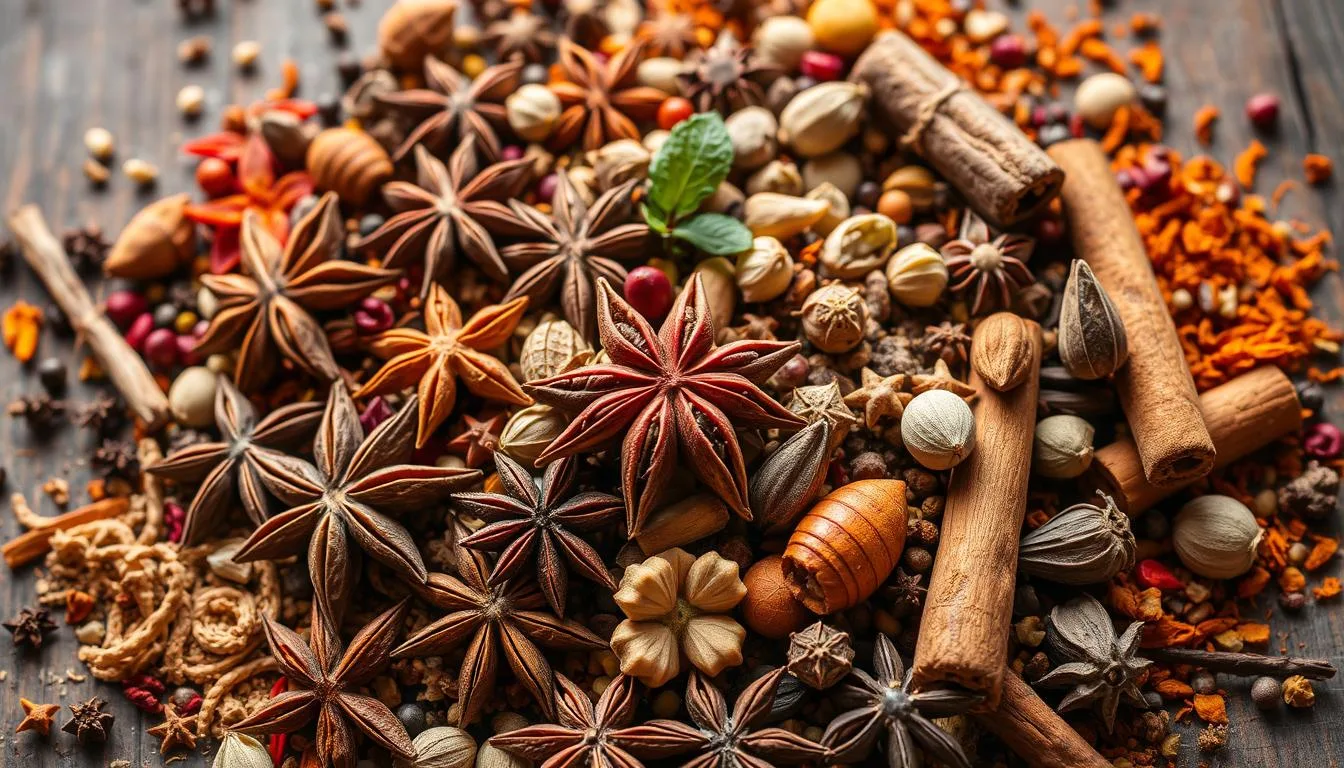how to bloom spices ? Imagine making your spices taste even better with a simple trick. Blooming spices isn’t just a trick—it’s a way to unlock deep flavors. For years, chefs have used this method. Now, you can too.
Mastering spice blooming opens up new culinary worlds. It’s not just about adding spices. It’s about bringing out their best flavors. Whether it’s a rich curry or a light sauce, bloomed spices can take your dish to the next level.
In this guide, we’ll dive into the art and science of spice blooming. You’ll learn why it’s important, how it works, and how to use it in your cooking. Get ready to change how you see flavor and improve your cooking skills.
Understanding the Art of Spice Blooming
Spice blooming is a special cooking technique that brings out the best in your favorite seasonings. It’s about unlocking the hidden flavors of spices. This method takes your cooking from good to great by enhancing flavors.
Cooking with spices is like an art that needs skill and knowledge. To make spice aromas better, you must understand the science behind it.
What Happens When Spices Bloom
When spices bloom, heat makes them change in a cool way. The oils inside the spices start to come out, giving a deep flavor. This works well with:
- Whole spices
- Ground spices
- Dried herb blends
The Science Behind Flavor Release
Heat changes the spice molecules. Volatile compounds are set free, bringing out flavors that were hidden. This is key for making your food taste rich and complex.
| Spice Type | Freshness Duration | Optimal Blooming Method |
|---|---|---|
| Whole Spices | Up to 3-4 years | Dry roasting |
| Ground Spices | Up to 2-3 years | Oil blooming |
| Herb Blends | Up to 1-2 years | Quick heat exposure |
Benefits of Proper Spice Blooming
Knowing how to bloom spices has many benefits:
- It makes flavors stronger
- It releases more antioxidants
- It adds depth to your dishes
Spices can provide up to 10 times more antioxidants than fruits and vegetables when measured per 100g.
Essential Tools and Equipment for Blooming Spices
Learning to bloom spices is more than just cooking. It needs the right tools. Your kitchen should have key items for amazing flavor.
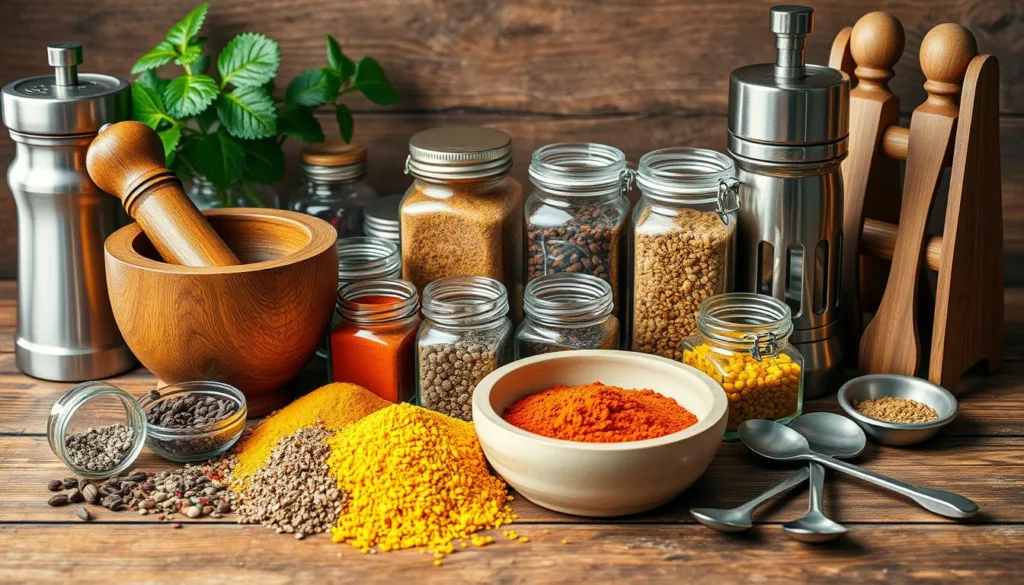
- Heavy-bottomed skillet or cast-iron pan
- Stainless steel or silicone spatula
- Digital instant-read thermometer
- Kitchen ventilation system
- Heat-resistant cooking gloves
Choosing the right pan is key. A heavy-bottomed skillet spreads heat well, avoiding burns. Cast-iron pans are great for their heat retention and non-stick surface.
“The right tool can transform a simple spice from mundane to magnificent.” – Professional Chef Recommendation
Keeping the right temperature is crucial. A digital thermometer helps you stay between 325°F and 350°F. This ensures the spices release their best flavors without burning.
| Tool | Purpose | Recommended Material |
|---|---|---|
| Skillet | Even heat distribution | Cast-iron or heavy-bottomed stainless steel |
| Spatula | Spice manipulation | Silicone or heat-resistant wood |
| Thermometer | Temperature monitoring | Digital instant-read |
Pro tip: Always ensure your kitchen is well-ventilated when blooming spices, as the process can release intense aromatic compounds.
How to Bloom Spices: Step-by-Step Process
Learning to bloom ground spices can make your cooking amazing. This method brings out deep, complex flavors that make simple dishes shine. By mastering the art of toasting spices, your meals will be more vibrant and aromatic.
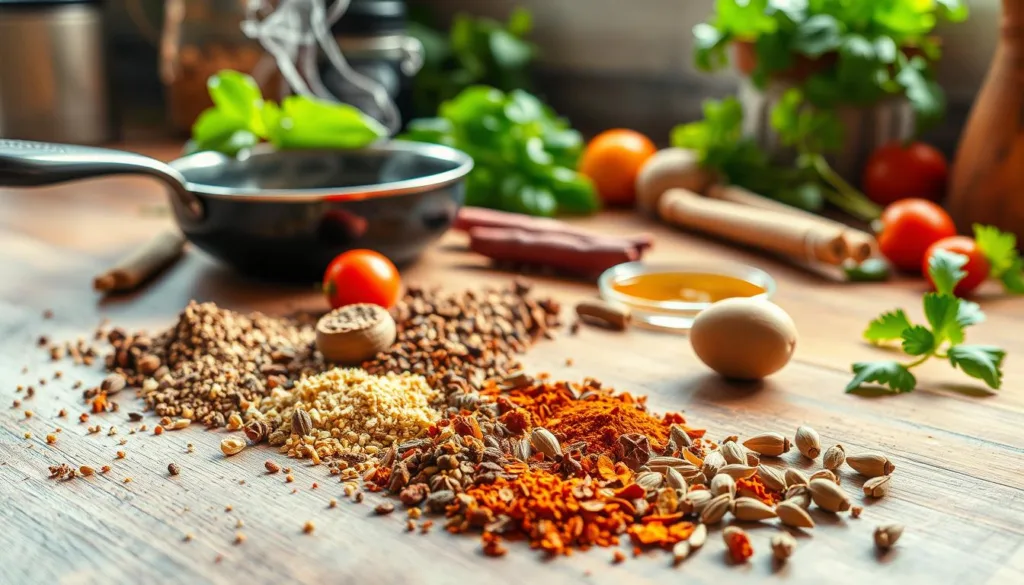
To bloom spices right, you need to pay attention to a few important things. Here are the key steps to get the best flavor.
Preparing Your Spices
First, get your spices and tools ready. Choose the best whole or ground spices for great results. Here are some tips to prepare:
- Pick fresh, fragrant spices
- Grind whole spices just before blooming for the best taste
- Measure spices carefully to avoid too much flavor
Temperature Control Techniques
Temperature is key when blooming spices. Here’s how to do it right:
- Use oils like canola or ghee that don’t burn easily
- Heat the oil to a medium-low temperature
- Check if the oil is ready by adding a spice – it should sizzle softly
Timing and Visual Cues
Getting the timing right is crucial for blooming spices. About 30 seconds is the best time to release flavors. Look for these signs:
- Spices start to smell good
- They slightly change color
- They brown a bit, but not too much
“The difference between good and great cooking often lies in how you treat your spices.” – Culinary Expert
Remember, burnt spices are not safe to eat. Keep an eye on them and take them off the heat if they get too dark. With practice, you’ll get better at blooming spices just right.
Dry Roasting vs. Oil Blooming Methods
Exploring spice preparation shows two main methods: dry roasting and frying in oil. Each method adds special qualities to your cooking, making simple ingredients into amazing dishes.
Understanding the Key Differences
Dry roasting spices means heating them in a pan without oil. Oil blooming, on the other hand, involves gently frying spices in a bit of fat. Both methods bring out strong flavors but in different ways.
Comparative Approach
| Method | Best For | Flavor Profile | Technique |
|---|---|---|---|
| Dry Roasting | Whole spices | Nutty, intense | Direct heat, no oil |
| Oil Blooming | Ground spices | Rich, complex | Medium-high heat, oil |
Practical Tips for Spice Blooming
- Use high smoke point oils like canola or avocado
- Watch for color changes and listen for sizzling sounds
- Limit oil to two tablespoons per dish
Blooming spices is an art that transforms ordinary cooking into an extraordinary culinary experience.
When dry roasting, keep spices moving to avoid burning. For oil blooming, aim for a quick 30-second process. This releases flavors without burning.
Choosing Your Method
Your choice depends on the recipe and desired flavor. Dry roasting is great for whole spices like cumin or mustard seeds. Oil blooming is better for ground spices in curries, stews, and sauces.
Pro tip: Practice and attention are key to mastering both dry roasting and oil blooming techniques!
Common Mistakes to Avoid When Blooming Spices
Learning to bloom spices is all about precision and understanding. Even seasoned cooks can face challenges. Knowing how to avoid these mistakes will improve your cooking and make your dishes better.
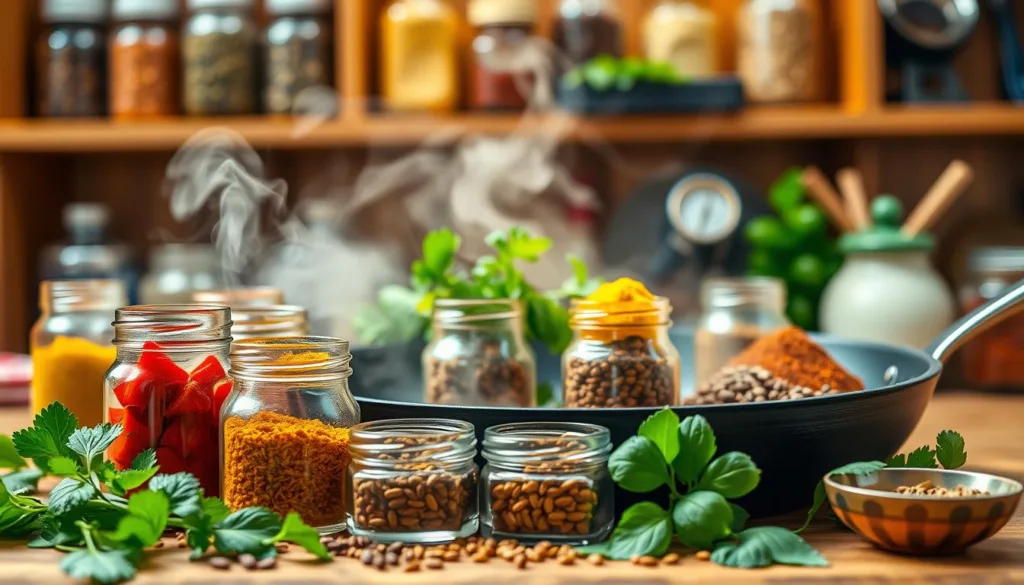
Blooming spices is an art that needs attention to detail. Knowing common mistakes helps avoid flavor disasters. This way, you can make more delicious meals.
Temperature Troubles in Spice Blooming
Temperature is key in activating spice flavors. Experts say 87% of cooks mess up with pan temperature. Here are some temperature mistakes to avoid:
- Using a cold pan, which traps moisture and prevents proper flavor development
- Overheating spices, which can burn delicate aromatic compounds
- Not maintaining consistent medium-low heat during blooming
Timing and Technique Challenges
Timing is crucial when learning to bloom spices. Mistakes in timing can lead to:
- Underdeveloped flavors
- Bitter or burnt spice notes
- Loss of essential aromatic oils
Properly blooming spices can enhance their flavor by up to 50%, unlocking aromatic compounds that remain hidden when added directly to dishes.
Spice Selection Errors
Not all spices are the same when it comes to blooming. Choosing the right spices is key for flavor success.
| Spice Type | Blooming Effectiveness | Recommended Method |
|---|---|---|
| Whole Spices | High | Oil blooming |
| Ground Spices | Medium | Short blooming time |
| Fresh Spices | Excellent | Gentle heat |
Remember, blooming spices needs patience and practice. By avoiding these common mistakes, you’ll improve your cooking. You’ll make more nuanced and flavorful dishes.
Best Spices for Blooming and Their Characteristics
Unlocking spice potential is an art that makes cooking special. Blooming spice mixes add deep, complex flavors quickly.
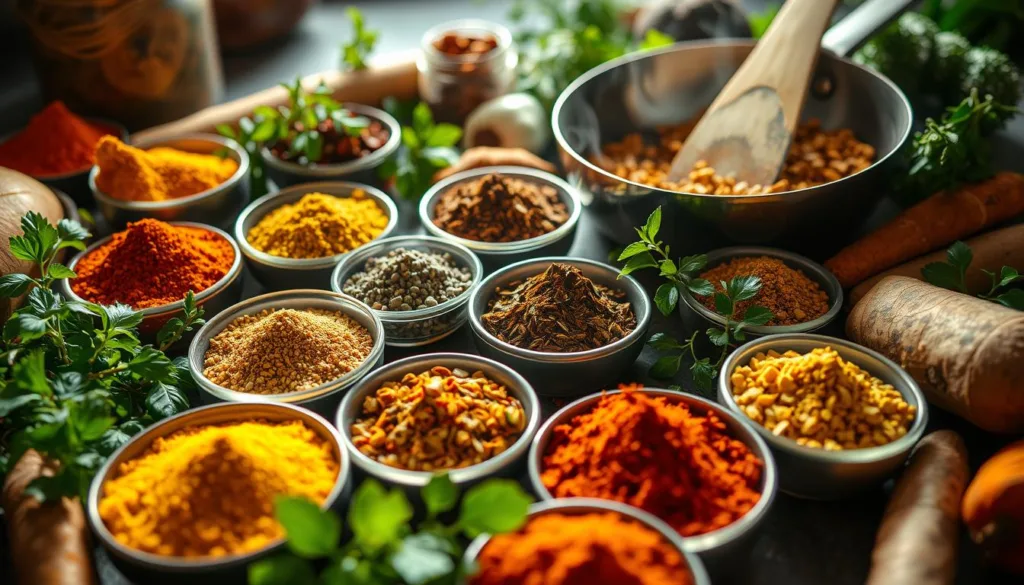
Not all spices bloom the same. Some spices reveal unique flavors that change your cooking.
- Cumin: Releases earthy, warm notes when bloomed
- Coriander: Develops nutty, citrusy undertones
- Cardamom: Unleashes intense aromatic compounds
- Mustard seeds: Creates a sharp, pungent essence
The science of blooming is interesting. When heated, spices release compounds that boost their flavor. Studies show bloomed spices can be up to ten times more flavorful.
*”Blooming is like waking up your spices, giving them a chance to sing their most vibrant song.”*
Temperature and timing are key. The best blooming time is 20-30 seconds at medium-low heat. This short time can change your dishes in many cuisines.
| Spice Category | Blooming Characteristics | Best Cooking Methods |
|---|---|---|
| Whole Seeds | Intense flavor release | Dry roasting, oil blooming |
| Ground Spices | Quick flavor activation | Brief oil infusion |
| Dried Herbs | Revived aromatics | Gentle heat application |
South Asian cuisines are experts at blooming spices like turmeric and ginger. Learning these techniques can make your home cooking taste like a restaurant.
Incorporating Bloomed Spices in Different Cuisines
Exploring the world of enhancing spice aromas takes us on a culinary journey across diverse cooking traditions. Blooming spice techniques transform ordinary dishes into extraordinary flavor experiences by unlocking the hidden potential of spices.
Culinary traditions around the globe showcase unique approaches to spice blooming, each bringing distinctive flavor profiles to their regional dishes.
Indian Cuisine: A Spice Blooming Masterclass
Indian cooking represents the pinnacle of blooming spice techniques. The traditional method of chhonk involves heating spices in hot oil to release their maximum flavor potential. Key spices like:
- Mustard seeds
- Cumin seeds
- Fenugreek seeds
- Dried chilies
Middle Eastern Culinary Traditions
Middle Eastern chefs elevate their dishes by carefully blooming spices in olive oil or ghee. Techniques like dry roasting and oil infusion create rich, complex flavor layers in staple dishes.
Modern Fusion Cooking Innovations
Contemporary chefs are reimagining blooming spice techniques by combining traditional methods with innovative approaches. Fusion cuisine blends cultural cooking styles, creating exciting new flavor combinations that respect authentic techniques while pushing culinary boundaries.
“Spices are the language of cooking, and blooming is how we make them speak.” – Chef Mehmet Rodriguez
Understanding these diverse approaches to enhancing spice aromas will transform your cooking, allowing you to create restaurant-quality meals in your own kitchen.
Storage and Preservation of Bloomed Spices
Keeping the flavors of bloomed spices alive needs careful storage. Learning how to bloom spices means knowing how to keep them fresh. This is key for their intense taste.
Unlocking the full flavor of spices is more than just cooking. Your storage plan can greatly affect the taste of your dishes.
“Proper storage is the secret to keeping your spices vibrant and flavorful.” – Culinary Experts
Key Storage Recommendations
- Use air-tight glass containers for maximum preservation
- Store in cool, dark locations away from heat sources
- Avoid refrigerator storage due to high humidity
- Decant spices immediately after purchase
| Storage Condition | Impact on Spice Quality |
|---|---|
| Direct Sunlight | Rapid flavor degradation |
| High Humidity | Mold growth and clumping |
| Near Heat Sources | Accelerated flavor loss |
Experts say to throw out spices that are over a year old. Whole spices last longer than ground ones. When storing bloomed spices, fight off oxygen and light to keep flavors fresh.
To get the best out of blooming spices, choose small, high-quality containers. This helps keep your spices away from air and light. Your spices’ flavors deserve the best care.
Advanced Techniques for Professional Results
Professional chefs have learned to unlock spice potential with advanced techniques. These methods take culinary experiences to new heights. They turn simple dishes into unforgettable meals.
Key advanced techniques include:
- Layered spice blooming for complex flavor profiles
- Creating intricate spice pastes
- Infusing oils with carefully bloomed spices
- Implementing traditional tempering methods
Spice blooming is all about precision. Temperature control is key to bringing out the best flavors. Chefs use medium heat to get the most out of spices without burning them.
| Technique | Flavor Enhancement | Recommended Heat |
|---|---|---|
| Dry Roasting | Intensifies nutty undertones | Low-Medium |
| Oil Infusion | Develops deep, rich flavors | Medium |
| Tempering | Creates aromatic base | Medium-High |
“Mastering spice blooming is like conducting a flavor symphony” – Chef Culinary Expert
Professional chefs say mastering spice blooming takes practice and patience. By trying different methods, you can make your cooking amazing.
Health Benefits and Nutritional Impact
Exploring the world of blooming ground spices reveals amazing health benefits. These go beyond just adding flavor. When you bloom spices right, you unlock a wealth of nutritional advantages that change how you cook.
Enhanced Digestibility
Blooming spices makes them easier for your body to digest and absorb nutrients. Spices like ginger and cumin become more digestible when heated. This helps your body process food better.
- Improved nutrient absorption
- Reduced digestive discomfort
- Activated beneficial compounds
Increased Bioavailability
Blooming spices releases compounds your body can use better. For example, turmeric’s curcumin becomes more bioavailable when heated in oil. This boosts its health benefits.
“Spices are not just flavors, they are nature’s medicine cabinet.” – Traditional Culinary Wisdom
Therapeutic Properties
Many spices have deep therapeutic properties when prepared right. Black pepper boosts nutrient absorption, while cinnamon helps control blood sugar. Your careful blooming technique unlocks these health benefits.
| Spice | Key Health Benefit | Daily Value % |
|---|---|---|
| Turmeric | Anti-inflammatory | 26% Manganese |
| Ginger | Digestive Support | 70% Manganese |
| Cinnamon | Blood Sugar Regulation | 68% Manganese |
By mastering blooming techniques, you turn ordinary spices into powerful health allies. They support your overall wellness.
Conclusion
Learning to bloom spices makes cooking special. It turns simple meals into flavorful masterpieces. This skill opens a door to centuries of cooking traditions.
Every spice has its own story. Cinnamon’s history goes back to the 1st century A.D. Herbs like oregano and thyme have special properties. Mastering blooming spices releases oils and compounds that boost taste and health.
Your cooking journey is just starting. Try new spices, temperatures, and methods. Whether it’s an Indian curry or a modern dish, your skills will impress. Spice blooming turns cooking into an art that delights all senses.
Great cooking is about passion and learning. Start blooming spices today. Discover a world of flavors in your kitchen.
Looking for more delicious recipes to try? Explore these amazing dishes on American Tasty:
- Red Lentil Soup with Warm Spices: A comforting, flavorful soup perfect for any season.
- Fishcakes and Scallops Stir-Fry Recipe: A quick and easy seafood dish with a savory twist.
- Chocolate Espresso Dacquoise: A decadent dessert that combines chocolate and coffee flavors.
- Crab Dip: A creamy, crowd-pleasing appetizer for any gathering.
- Pea Salad: A fresh, vibrant side dish that’s perfect for summer meals.
- Breakfast Lasagna: Start your day with a hearty and unique breakfast recipe.
- Pumpkin Soup: A rich, velvety soup that’s ideal for autumn evenings.
Join Our Community!
💬 Facebook: Stay updated with our latest recipes, cooking tips, and delicious inspiration. Join the conversation and share your creations with us on American Tasty’s Facebook page.
📌 Pinterest: Discover mouthwatering recipe ideas and save them for later! Follow our boards on American Tasty’s Pinterest for endless culinary inspiration.
✨ Why Join?
- Get exclusive recipes and updates.
- Share your food creations and inspire others.
- Connect with a community of food lovers like you!
FAQ
What exactly does “blooming spices” mean?
Blooming spices is a cooking method. It involves heating whole or ground spices in oil or dry heat. This releases their essential oils, making their flavors and aromas more intense.
What are the main benefits of blooming spices?
Blooming spices brings several benefits. It deepens flavors, enhances aromas, and improves how spices blend with dishes. It also adds complexity to taste. This technique unlocks spices’ full potential.
Which spices work best for blooming?
Spices like cumin, coriander, mustard seeds, cardamom, and fennel seeds are great for blooming. They have strong flavors that become even more vibrant when heated. This makes your dishes taste richer and more nuanced.
What’s the difference between dry roasting and oil blooming?
Dry roasting heats spices in a dry pan, creating a nutty flavor. Oil blooming, or tempering, uses oil to extract and distribute flavors. Each method suits different recipes and desired tastes.
Can I bloom spices in advance?
While best done just before cooking, you can bloom spices a few hours ahead. Store them in an airtight container in a cool, dark place. But for the best flavor, bloom them right before adding to your dish.
What common mistakes should I avoid when blooming spices?
Avoid overheating, which can make spices bitter. Also, don’t use low heat or burn spices. Use medium heat, watch for color and aroma changes, and stir spices to prevent burning.
Are there health benefits to blooming spices?
Yes, blooming can make spices easier to digest and increase their health benefits. Many spices have antioxidants and anti-inflammatory properties. These become more available through blooming, offering nutritional advantages.
Can I use bloomed spices in different cuisines?
Absolutely! Blooming spices is key in Indian and Middle Eastern cooking. But it’s also used in many other cuisines. Modern cooking often uses bloomed spices to create new and complex flavors.

